Fördern Sie die realen Anwendungsfälle von DeAI und konzentrieren Sie sich auf das zugrunde liegende Protokoll der dezentralen KI, das KIP-Protokoll, um Mill
Originalautor: flowie, ChainCatcher
The AI+Web3 track has become active again. In the past month, the AI+Web3 track has disclosed nearly 20 financings, and leading institutions such as a16z and Binance Labs have made consecutive moves. However, with the rampant high FDV projects this year, the AI+Web3 narrative favored by capital has once deterred many crypto users.
In fact, with exchanges such as Binance cracking down on high FDV projects, and other participants in the crypto market reflecting on the high FDV dilemma in recent months, the market has also undergone some potential changes. Looking at the recently active AI+Web3 projects, some projects are strictly controlling FDV and making efforts to apply it, breaking away from the vicious circle of selling coins at high valuations with only narratives.
Recently, KIP Protocol, a decentralized AI infrastructure layer led by Animoca Ventures and Tribe Capital, is one of them. KIP Protocol is the first underlying protocol to support the decentralized retrieval-augmented generation network (dRAG) and is also the leading project in the dRAG track.
KIP Protocol attempts to solve the pain points faced by AI model makers, App developers, and data owners when trying to decentralize through dRAG, allowing knowledge and data to be protected and monetized as intellectual assets, ensuring that they interact with artificial intelligence without losing ownership.
KIP Protocol is currently accelerating the application of DeAI+Education, DeAI+Entertainment and other fields, bringing millions of Web2 users into Web3, and promoting the large-scale adoption of Web3+AI.
The world has long suffered from high FDV
In the past year, tokens with a high FDV, low circulation model have been rampant. These tokens will continue to be unlocked after TGE, causing a large amount of selling pressure on the market, and the price performance is generally weak.
In a report released in May this year, Binance Research pointed out that the FDV of tokens launched in the first four months of 2024 is close to the total number in 2023. And the market capitalization (MC) to FDV ratio of tokens launched in 2024 is the lowest, about 12.3%. The MC/FDV ratios of tokens in 2022 and 2023 are 41.2% and 26.7% respectively.
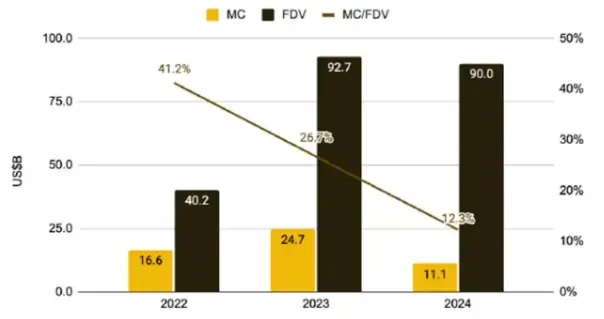
Binance Research estimates that approximately $155 billion worth of tokens will be unlocked from 2024 to 2030. That is to say, without such a large influx of funds, many tokens will face huge selling pressure and there will be little room for upside.
According to statistics from crypto KOL @Ryanqyz_hodl, most of the tokens listed on Binance in 2024 all fell sharply after TGE.
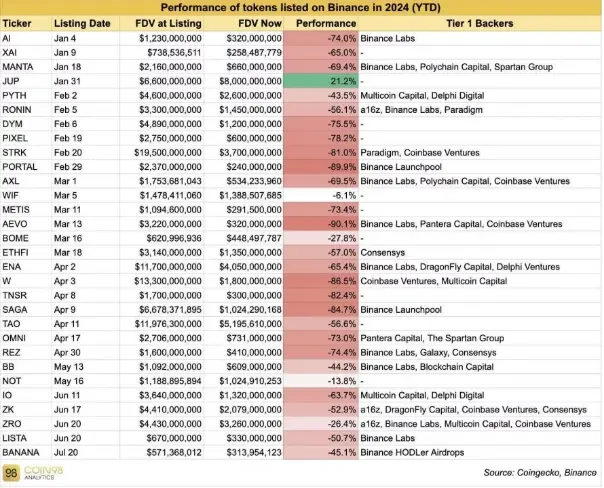
(Data source: @Ryanqyz_hodl)
This has also led to a large number of retail investors becoming victims after the TGE of many projects, and even some investors such as VCs may face the dilemma of only paper wealth due to the unlocking period. Therefore, the high FDV, low circulation model has also become the focus of criticism from a large number of community users, and is widely regarded as one of the culprits that caused this round of bull market to become a false bull market.
As the high FDV and low circulation model becomes more and more controversial, the crypto exchange Binance took the lead in adjusting its listing strategy: On the evening of May 20, Binance announced a public recruitment plan for listing projects, stating that the high valuation and low circulation model would be detrimental to ordinary investors and loyal community members of the project. In order to cultivate a healthy industry ecosystem, Binance will take the lead in supporting small and medium-sized cryptocurrency projects. The founder of OKX also tweeted that exchanges should not become accomplices of high FDV and low circulation projects.
With the rectification of the leading exchanges and the collective reflection of other crypto participants, pioneers such as KIP Protocol have begun to appear on the market to solve the high FDV encryption dilemma.
Adhering to the principle of low FDV, the popularity of KIP community exceeded expectations
Web3+AI is one of the most favored tracks by capital this year. The involvement of too many investment institutions and institutional funds can easily give rise to highly valued projects.
According to CoinGecko data, as of September 24, the FDV of the open source AI project Bittensor has reached US$11.5 billion, and the FDV of the decentralized GPU infrastructure Aethir has also reached US$2.6 billion.
Among the Web3+AI concept projects that recently announced financing, Sahara AI and Vana received financing amounts of US$43 million and US$25 million respectively, which are bound to correspond to extremely high valuations.
In comparison, KIP Protocol is very restrained in financing, and its valuation is also at a relatively low level among a number of Web3+AI concept projects.
Recently, KIP Protocol announced that it has completed a $5 million private equity financing led by Animoca Ventures and Tribe Capital. According to the token economic model published in the KIP Protocol white paper, the Private Sale accounts for 10% of the total token issuance, which estimates that the current valuation of KIP Protocol is about $50 million. 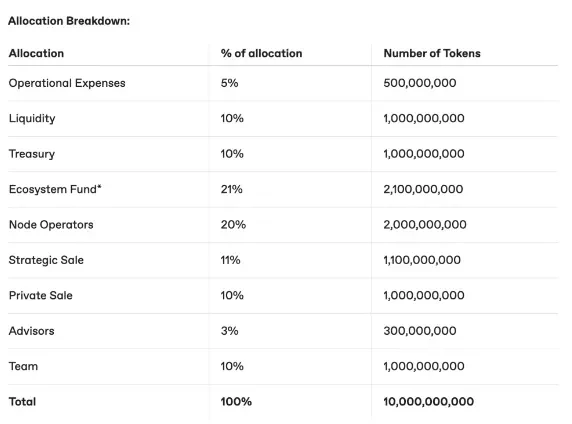
According to KIP Protocols previous node sales model, it provides lower potential FDV for early participants by introducing lower-level nodes at the beginning of the sale. KIP takes out 20% of the total tokens for node rewards, and the corresponding valuation of Tier 1 nodes is also 50 million US dollars, which is much lower than the corresponding valuation of Tier 1 nodes of projects such as Aethir, Sophon, and Carv.

As one of the current leaders in the dRAG track, KIP has an impressive team background and is backed by top investment institutions. It may be beyond everyones expectations that it can insist on a low valuation in such a broad sense.
According to public information, KIP co-founder and CEO Julian Peh is a serial entrepreneur and investor who has experienced multiple Internet cycles, spanning the Internet Web1, Web2 and entering We 3 in 2016. Julian Peh also had a high starting point in Web3: he founded a consulting company that provides research and communication services, and has provided services to venture capital firms such as Animoca Ventures.
In addition, Dr. Jennifer Dodgson, who founded the well-known AI project Eigenform, is currently KIPs Chief AI Strategy Officer. She has provided AI consulting services to many large clients.
According to the official website, the KIP team also brings together talents with diverse backgrounds such as AI, payment, data analysis, and investment, and most of the team members come from the leading companies in these fields.

KIPs technical solutions and application value have also been initially recognized. At the 2023 Chainlink Hackathon, KIP stood out from more than 18,500 participating projects and won the Tencent Cloud Award.
The teams own experience and strength in AI, data services and other fields also make community users have high expectations for KIP. In April this year, the Genesis NFT sold by KIP received a high level of participation, and 3,888 NFTs were quickly minted out within 4 minutes of the public sale. KIP node sales also exceeded market expectations. In the previous community node sales, 400 nodes each from Tiers 1 to 3 were sold out in about 2 hours.
Judging from the teams solid industry background and previous operating performance, KIPs ability to maintain a low valuation may also be due to the potential for future applications of its decentralized RAG protocol.
KIP does not need to dump tokens through a high valuation model, but instead focuses on the long-term value and large-scale application of its decentralized RAG protocol, providing users with real use cases to complete the business closed loop.
Get rid of the vicious circle of only talking about narrative and not talking about application
Behind this round of bull market relying on the high FDV, low circulation model is the fact that the Web3 capital market has created a false prosperity without creating real value. Crypto KOL Ryanqyz reflected on the X platform that all participants in the crypto industry have fallen into a vicious cycle of creating unreal stories, not doing practical things, and just wanting to sell coins.
When the narrative-driven model of the crypto market no longer works, what should we do next? Ryanqyz believes that the market needs to enter the real application cycle and return to a venture capital environment similar to the traditional Web2 field that prefers projects with real income and real use cases.
As a team that has experienced the complete cycles of Web1 and Web2 and has successful entrepreneurial experience, the KIP team has had in-depth thinking on the applicability of technology and business models since its inception: KIPs decentralized RAG (retrieval-augmented generation) technology is in high demand in fields that require the latest and sensitive data sources, such as games, education, healthcare, and asset management.
Julian Peh, co-founder and CEO of KIP, once shared in Space how KIP can help the education sector solve the problems of intellectual property rights and profit distribution. Julian Peh mentioned that the three core elements that KIP focuses on are models, apps, and data.
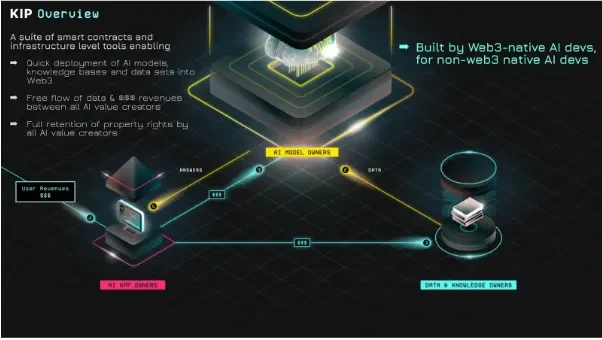
Suppose there is a university textbook that has intellectual property (IP). KIP can put this textbook into a knowledge base, then process this knowledge through a model, and provide an APP to help students answer questions, or use this textbook to generate test papers, forming a complete AI product.
At the same time, KIP can solve the problem of these AI assets deployed on Web3 so that each creator can retain their ownership. KIP will also connect all parties to generate interactions and answers, and solve the problem of profit distribution among all parties through smart contracts.
Deeply cultivate DeAI + Education and DeAI + Entertainment to promote the large-scale adoption of Web3 + AI
Currently, KIP has started from the fields of education and entertainment to accelerate the application of its technology.
In the field of DeAI + Education, in April this year, KIP Protocol reached a cooperation with Open Campus, a leading Web3 education project. Open Campus and the education company behind it have received investment support from Animoca Brands and Binance Labs, and Open Campus has also been launched on Binance Launchpad.
Through this collaboration, KIP helped Open Campus integrate KIP’s decentralized Retrieval Augmented Generation infrastructure, enabling educators to provide students with their 24/7 digital AI “twin” versions that adapt to students’ learning progress in real time. At the same time, KIP helps educators create and control their AI assets (“KnowledgeKeys”) and enjoy complete digital property rights and reasonable returns.
In addition to business-level cooperation, KIP Protocol has also received funding and strategic support from Open Campus: In early August, KIP Protocol announced that its OCP-12 proposal was passed unanimously, and obtained the management rights of the $10 million fund established by Open Campus to continue building the decentralized AI learning platform Open Campus U (OCU), which aims to transform the education industry through AI and Web3 technologies, affecting 250 million students worldwide and covering 23,000 universities.
According to the approved proposal, KIP has set specific strategic goals in the next 18-24 months, including recruiting 400 professors, offering 900 selected courses, and attracting 1 million new learners to join Open Campus.
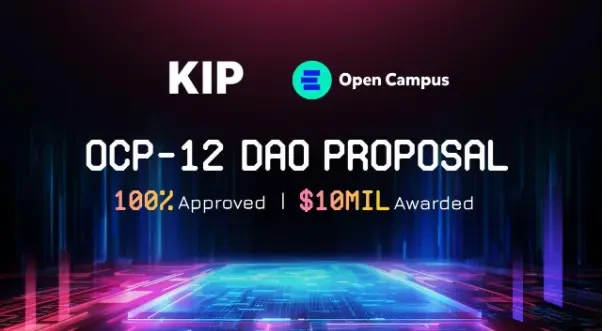
From the all-round cooperation between KIP and Open Campus, it is not difficult to see their close relationship. KIP Protocol should be one of the most core AI encryption service providers of Open Campus.
In addition to the education field, KIP has also recently expanded into the DeAI + Entertainment field: In July, KIP Protocol reached a strategic cooperation with Moemate, a well-known Entertainment AI project.
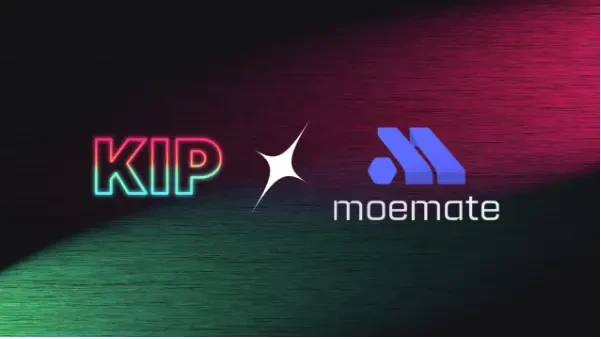
Moemate is an AI Agent platform with over 3 million users. It has built an ecosystem of mixed reality AI Agents from chatbots to AR/VR, including personalized AI companions that can play games with users, and AI NPCs in games.
KIP will help Moemate gradually decentralize its architecture, such as supporting account abstraction, tokenization and trading of roles, skills and models, community-driven AI asset investment and crowdfunding, and fiat and cryptocurrency payments.
By empowering Moemate, KIP will lead more than 3 million Web2 AI users into the Web3 field.
KIP also has its own advantages in ecological expansion. As the core AI project in the Animoca ecosystem, KIP is rapidly expanding its ecosystem by leveraging the network effect of hundreds of Animoca projects. It is expected that more application cases will be implemented in the second half of the year.
Abschluss
At present, the market generally believes that the advent of the traffic era and the change in Binance listing aesthetics will be huge opportunities for Web3 projects with healthy FDV and focus on applications.
Among a number of Web3+AI narrative projects, KIP, as one of the first representative projects to maintain low FDV, is using its decentralized RAG protocol to help platforms seeking decentralized AI solutions, such as Open Campus, the leader in Web 3 education, and Moemate, the leading project in Entertainment AI, to solve their problems, in order to promote the large-scale application of DeAI + Education and DeAI + Entertainment, and bring millions of Web2 AI users into Web3.
With the arrival of the interest rate cut cycle and the start of a larger bull market, KIP is expected to release greater value and potential.
This article is sourced from the internet: Promote the real use cases of DeAI and focus on the underlying protocol of decentralized AI, KIP Protocol, to bring millions of Web2 AI users into Web3
Related: SignalPlus Macro Analysis (20240919): FOMC meeting key points summary – Confidently Dovish
Chairman Powell met the expectations of risk markets with a 50 basis point rate cut, but for choosing a more substantial rate cut this time, he also confidently emphasized that a soft landing of the economy remains the basic scenario, and repeatedly reiterated that the U.S. economic performance is quite good. Key Summary: With inflation falling, a soft landing remains the base case. The U.S. economy is in good shape, and our decision today is to keep it that way. The U.S. economy is basically fine. I believe inflation will fall to 2%. Stay ahead. Powell pledged to “stay ahead” in rate adjustments in response to the slowdown in the job market, with a particular eye on hiring rates (the 50 basis point rate cut is our commitment not to…







